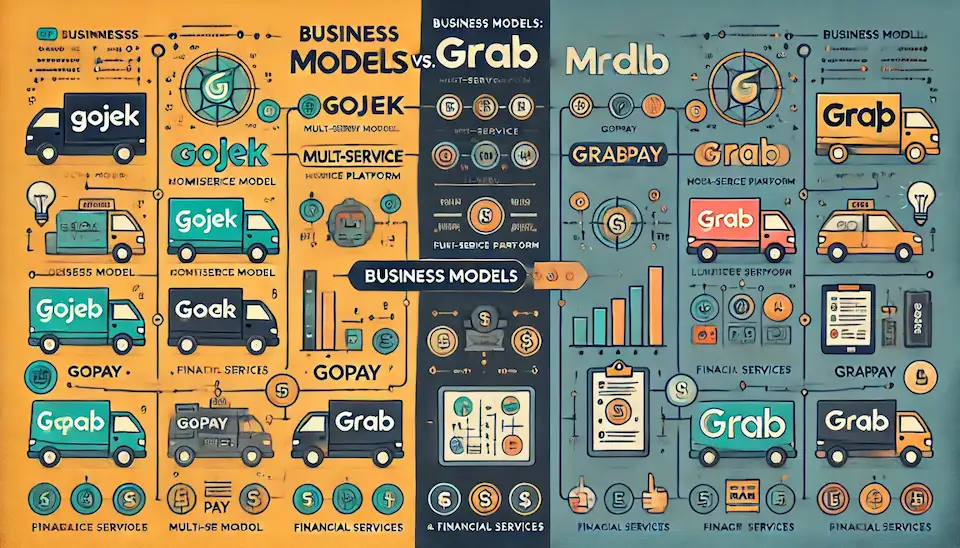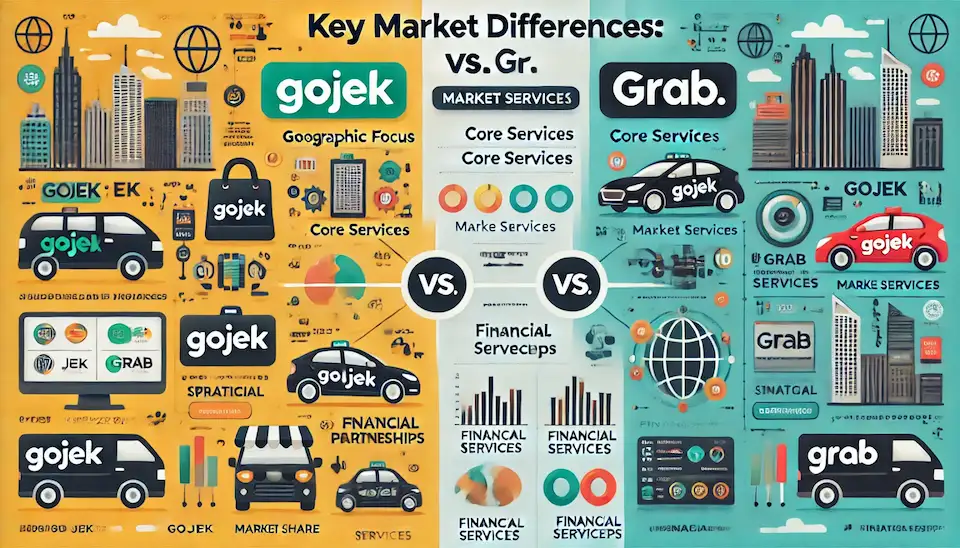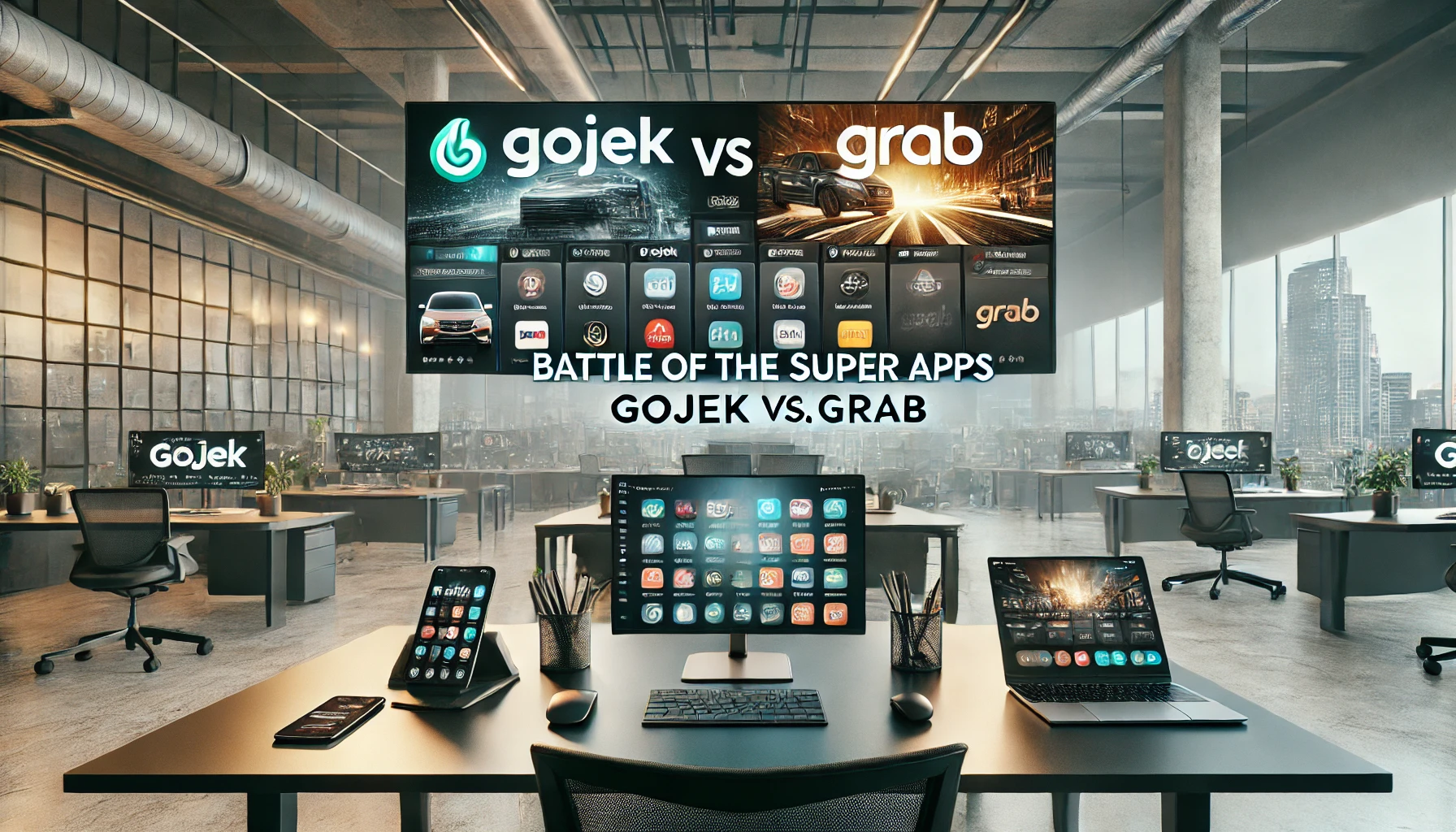Before we dive into the battle of the super Apps, let us understand the idea of top super apps in market. In the Southeast Asian market, Gojek e Pegar stand as two of the most dominant super apps, offering a wide range of services from ride-sharing para entrega de comida e financial services. But which model wins in terms of business strategy, user engagement, e revenue generation? This comparative blog will break down the business models, Principais características, e market performance of both apps to help businesses and users alike understand which platform holds the competitive edge.
Gojek vs. Grab – A Battle of Southeast Asia’s Super Apps
In the fast-growing digital economy of Southeast Asia, Gojek e Pegar have emerged as the leading super apps, each offering a comprehensive suite of services that range from ride-hailing e entrega de comida para financial services. Both companies have developed distinct business models and features to cater to the diverse needs of millions of users across the region.
Enquanto Gojek started in Indonesia as a simple motorcycle ride-hailing app, it has since evolved into a multi-service platform that offers everything from logistics to healthcare. Similarly, Pegar, which began in Malaysia as a ride-hailing service, has expanded into a multi-faceted platform with offerings like food delivery, digital payments, and financial products.
But which super app model is better? In this blog, we will compare Gojek vs. Grab, analyzing their business models, key features, market performance, and service diversity to determine which platform holds the competitive edge.
Business Models: Gojek vs. Grab
Ambos Gojek e Pegar have evolved into full-fledged super apps, but their business models have some notable differences. Understanding these models helps explain how each company generates revenue and scales its services.
1. Gojek Business Model
- Multi-Service Platform: Gojek operates as a multi-service platform, offering over 20 services through its app, including ride-hailing, entrega de comida, comércio eletrônico, financial services, and even healthcare.
- Fontes de Receita:
- Modelo baseado em comissão: Gojek earns a commission from each transaction made on its platform, whether it’s for transportation, food delivery, or logistics.
- Subscription and Freemium: In some regions, Gojek offers premium subscription services for users who want additional perks, such as faster deliveries or discounts.
- In-App Payments: Through its digital wallet, GoPay, Gojek facilitates millions of transactions, earning fees from each one.
- Key Strength: Gojek’s success lies in its deep penetration in Indonesia, where it has captured a loyal customer base by offering hyper-local services and catering to daily needs.
2. Grab Business Model
- Multi-Faceted Super App: Like Gojek, Pegar offers a wide variety of services, including ride-sharing, entrega de comida, digital payments, insurance, e logistics. However, Grab also places a strong emphasis on financial services, including loans and insurance.
- Fontes de Receita:
- Modelo baseado em comissão: Grab, like Gojek, charges a commission on every ride, food order, and service booked through its app.
- GrabPay: Grab has aggressively pushed its digital wallet, GrabPay, integrating it with multiple services and earning revenue from payment processing.
- Financial Services: Grab is expanding into lending e insurance, offering personal loans, micro-financing, and insurance services through its app.
- Key Strength: Grab’s focus on financial inclusion and its expansion into the FinTech space gives it a competitive edge, especially in regions where traditional banking infrastructure is underdeveloped.

Key Features Comparison: Gojek vs. Grab
While both Gojek e Pegar offer a variety of services, their key features cater to different markets and user needs. Let’s compare the features that define each platform:
| Recurso | Gojek | Pegar |
| Core Services | Ride-hailing, Food delivery, E-commerce, Logistics, Financial Services (GoPay), Healthcare | Ride-hailing, Food delivery, Financial services (GrabPay), Insurance, Logistics, E-commerce |
| Ride-Hailing Options | Motorcycle taxis, cars, vans | Cars, motorcycles, vans |
| Entrega de comida | GoFood – Fast-growing, deep restaurant network in Indonesia | GrabFood – Extensive reach across Southeast Asia |
| Gateway de pagamento | GoPay – In-app wallet, used across multiple services, dominant in Indonesia | GrabPay – Expanding across services, especially strong in payments and lending |
| Financial Services | GoPay: Peer-to-peer transfers, payments | Grab: Peer-to-peer transfers, lending, micro-insurance |
| Service Variety | 20+ services, including healthcare, e-commerce, and package delivery | 15+ services, with a focus on financial inclusion and expanding FinTech offerings |
| Loyalty Programs | GoClub – Rewards for using services | GrabRewards – Points system, strong user retention |
| Geographical Presence | Primarily in Indonesia but expanding to Southeast Asia | Strong in Southeast Asia, including Singapore, Malaysia, Philippines, and Vietnam |
| Social Impact | Focus on empowering local businesses e drivers through partnerships | Focus on financial inclusion, offering services to underbanked regions |
Which Features Stand Out?
- Gojek’s Unique Strengths: Gojek has a deeper presence in Indonesia, offering localized services such as GoSend (courier service) and GoMed (telemedicine). Its focus on healthcare and logistics makes it a highly versatile platform in the region.
- Grab’s Unique Strengths: Grab’s strength lies in its financial services como GrabPay, loans, e micro-insurance, which cater to users across Southeast Asia. Its integration of financial inclusion tools sets it apart, especially in regions where banking infrastructure is limited.
Key Market Differences: Gojek vs. Grab
While both Gojek e Pegar dominate the super aplicativo ecosystem in Southeast Asia, their approach to markets and services differs significantly. Here are the key market differences between the two:
1. Geographic Focus
- Gojek:
- Key Market: Gojek’s primary focus is Indonesia, where it has a strong foothold in key services like ride-hailing, entrega de comida, e digital payments through GoPay.
- Impacto no mercado: Gojek dominates the Indonesian market, with 60% market share in ride-hailing and a significant portion of food delivery through GoFood. However, outside Indonesia, Gojek is still expanding and has yet to establish the same dominance in other Southeast Asian countries.
- Pegar:
- Key Market: Grab operates across multiple countries in Southeast Asia, including Singapore, Malaysia, Vietnam, Thailand, and the Philippines.
- Impacto no mercado: Grab has a much broader geographic footprint than Gojek, with 70% market share in ride-hailing across Southeast Asia. Its regional dominance makes it the go-to super app across these countries, with a strong presence in food delivery, transportation, and financial services.
2. Core Services and Diversification
- Gojek:
- Service Strength: Gojek offers a wide range of serviços hiperlocais in Indonesia, including GoSend (courier services), GoMed (telemedicine), and GoBox (logistics). This makes it deeply integrated into the daily lives of Indonesian users.
- Market Difference: Gojek is highly localized, focusing on delivering a diverse set of services tailored to the Indonesian market, but its international expansion remains a challenge due to competition from Grab.
- Pegar:
- Service Strength: Grab’s focus is on providing regional services like ride-hailing, GrabFood, e GrabPay across Southeast Asia. Grab has also aggressively expanded into financial services, oferecendo microcréditos, insurance, e digital payments, positioning itself as a FinTech leader.
- Market Difference: Grab is less focused on localizing its services for individual countries and more on standardizing its offerings across multiple regions. Its diversified service portfolio, especially in FinTech, gives it a distinct advantage in markets with underdeveloped financial infrastructure.
3. Market Share and User Base
- Gojek:
- Market Share: Gojek is the dominant super app in Indonesia, with over 60% market share in ride-hailing and a significant presence in food delivery and logistics.
- User Base: Gojek has more than 190 million users, the majority of whom are in Indonesia. This concentrated user base gives Gojek a strong foothold in its home market but limits its influence in the broader Southeast Asian region.
- Pegar:
- Market Share: Grab commands a 70% market share in ride-hailing across Southeast Asia and leads in the food delivery market with a 50% share across key countries like Cingapura, Malaysia, e Vietnam.
- User Base: Grab’s user base exceeds 187 million across multiple Southeast Asian countries, giving it a strong regional presence. Grab’s diverse services and broader reach allow it to capture a more regionally diverse audience.
4. Financial Services and Payments
- Gojek:
- GoPay: Gojek’s GoPay is a powerful digital wallet and payment solution in Indonesia, widely used for peer-to-peer transfers, in-app purchases, and bill payments. However, its penetration outside Indonesia remains limited.
- Market Difference: Gojek has not expanded its financial services as aggressively as Grab. GoPay is predominantly focused on transactions within the Gojek ecosystem and lacks the broader financial offerings that Grab has introduced regionally.
- Pegar:
- GrabPay: Grab has positioned GrabPay as a leading digital wallet across Southeast Asia, with extensive offerings in payments, micro-lending, e insurance. Grab’s aggressive push into FinTech has made it a dominant player in both the ride-hailing e digital payments markets.
- Market Difference: Grab’s focus on financial inclusion gives it a significant edge in markets where traditional banking infrastructure is lacking. Its expansion into digital banking sets it apart as a super app with a long-term vision for financial services.
5. Strategic Investments and Partnerships
- Gojek:
- Parcerias locais: Gojek’s partnerships are primarily focused on local businesses in Indonesia, such as its merger with Tokopedia to form the GoTo group. This positions Gojek as a major player in Indonesia’s digital economy, combining comércio eletrônico, logistics, and financial services under one umbrella.
- Market Difference: Gojek’s partnerships are heavily focused on dominating Indonesia, but its lack of significant regional partnerships limits its growth potential outside the country.
- Pegar:
- Regional Partnerships: Grab has formed strategic partnerships across Southeast Asia, including partnerships with banks, insurance companies, e logistics providers. Grab has also secured digital banking licenses in countries like Cingapura e Malaysia, further expanding its FinTech footprint.
- Market Difference: Grab’s partnerships enable it to diversify its service offerings and scale rapidly across multiple countries. Its focus on partnerships in the financial sector sets it apart from Gojek, especially in terms of long-term growth potential in digital banking.

Performance Metrics Comparison: Gojek vs. Grab
To better understand how Gojek e Pegar perform in the market, we can look at several key performance metrics, such as user base, revenue, geographical presence, e service variety. Here’s a detailed comparison:
| Performance Metric | Gojek | Pegar |
| User Base | Over 190 million users (2024) | Over 187 million users (2024) |
| Revenue (2023) | Approx. $3.8 billion | Approx. $4.5 billion |
| Number of Services | 20+ services across multiple industries | 15+ services with a strong focus on financial inclusion |
| Market Share | Dominates Indonesia (~60% market share in ride-hailing) | Leads in Southeast Asia, especially Singapore and Malaysia (~70% ride-hailing share) |
| Food Delivery Market Share | GoFood holds ~40% share in Indonesia | GrabFood holds ~50% share in Southeast Asia |
| Financial Services | Strong in Indonesia via GoPay | Leading in Southeast Asia with GrabPay, loans, and insurance |
| Geographical Presence | Primarily in Indonesia and expanding to other Southeast Asian countries | Strong presence in Singapore, Malaysia, the Philippines, Vietnam |
| Funding Raised | Approx. $5 billion | Approx. $12 billion |
Key Takeaways from Performance Metrics
- User Base: Both Gojek and Grab have comparable user bases, but Pegar has a slight edge in overall Southeast Asia, whereas Gojek dominates in Indonesia.
- Receita: Grab’s diversified financial services and wider geographical presence have helped it generate higher revenue than Gojek.
- Market Share: Pegar leads in the overall Southeast Asian region, while Gojek holds a commanding lead in Indonesia.
- Entrega de comida: Both super apps are strong in the food delivery segment, but GrabFood edges out GoFood in terms of market share across Southeast Asia.
Market Share Comparison: Gojek vs. Grab
Understanding the market share of Gojek e Pegar is essential to grasp their dominance in the Southeast Asian super app ecosystem. Here’s a breakdown of their market presence:
1. Ride-Hailing Market Share
- Gojek: Gojek commands a dominant 60% market share in Indonesia, its home country, where it has become the leading ride-hailing app.
- Pegar: Grab, however, holds a strong foothold in Southeast Asia, with over 70% market share in regions like Singapore, Malaysia, and the Philippines. Its ride-hailing dominance covers a broader area than Gojek’s, making it a more regionally diverse player.
2. Food Delivery Market Share
- Gojek (GoFood): Gojek holds around 40% market share in Indonesia, but its food delivery services are mainly focused on this single market.
- Grab (GrabFood): GrabFood is the leading food delivery service in Southeast Asia with 50% market share, particularly strong in countries like Cingapura, Tailândia, e Vietnam. This gives Grab an edge in the food delivery sector across the region.
3. Financial Services and Digital Payments
- Gojek (GoPay): Gojek’s digital wallet, GoPay, is widely used in Indonesia and supports peer-to-peer transfers, bill payments, and e-commerce transactions. However, its presence outside Indonesia is still growing.
- Grab (GrabPay): GrabPay has a broader presence across Southeast Asia, offering payment solutions along with lending e micro-insurance. Grab’s focus on financial inclusion has helped it capture a significant share of the digital payment e FinTech market in the region.
4. Overall Market Presence
- Gojek: Gojek’s influence is most profound in Indonesia, where it dominates both the ride-hailing and food delivery markets. Outside Indonesia, Gojek is still expanding and establishing its presence in countries like Vietnam e Tailândia.
- Pegar: Grab has a regional advantage, leading the Southeast Asian market with operations in 8 countries, including Cingapura, Malaysia, e Vietnam. Its focus on offering a wide array of financial services, along with logistics and food delivery, has helped Grab maintain the largest share across multiple sectors.
Key Takeaways
- Gojek leads in Indonesia, but Pegar dominates Southeast Asia as a whole.
- Pegar has a stronger presence in financial services, while Gojek is still consolidating its super app offerings outside of Indonesia.
- Both apps are fierce competitors in the food delivery and ride-hailing segments, but Grab’s broader geographical presence gives it an edge in the overall Southeast Asian market.
Which App is Better: Gojek or Grab?
Deciding whether Gojek ou Pegar is the better super app depends largely on the perspective you’re looking at—whether it’s in terms of business model, características, regional influence, ou future growth potential. Both apps excel in different areas, so let’s break down their strengths:
1. Best for Regional Dominance: Grab
- Why Grab Wins: Grab has a broader presence across Southeast Asia, operating in 8 countries, including key markets like Singapore, Malaysia, Vietnam, e Tailândia. Its regional influence is unmatched, giving it the lead in overall market share for ride-hailing, entrega de comida, e financial services across the region.
- Key Strength: Grab’s strong integration of financial services, including GrabPay, loans, e insurance, has positioned it as more than just a ride-hailing or food delivery app. Its focus on financial inclusion offers long-term growth potential in markets where banking infrastructure is still developing.
2. Best for Localized Services: Gojek
- Why Gojek Wins: While Gojek’s influence is more concentrated in Indonesia, its hyper-local focus has made it a household name. Gojek’s success in Indonesia is largely due to its ability to tailor services like GoFood, GoSend, e GoMed to meet the specific needs of the local market.
- Key Strength: Gojek offers more localized services that cater directly to the daily needs of Indonesian users, such as telemedicina, courier services, e logistics. Its deep connection to Indonesian consumers gives it a dominant 60% market share in ride-hailing in Indonesia.
3. Best for Financial Services: Grab
- Why Grab Wins: Grab’s financial services division, powered by GrabPay, is a significant differentiator. The company has aggressively expanded into FinTech with products like microcréditos, insurance, e digital payments. This positions Grab not only as a super app but also as a key player in the growing digital financial services market in Southeast Asia.
- Key Strength: Grab’s focus on financial inclusion helps users without access to traditional banking, giving it a unique value proposition, especially in underbanked regions.
4. Best for Service Variety: Gojek
- Why Gojek Wins: Gojek offers a broader variety of services, including healthcare through GoMed and comprehensive logistics services like GoSend e GoBox. This makes Gojek a more versatile platform in terms of everyday utility, especially for local users in Indonesia.
- Key Strength: Gojek’s extensive list of 20+ services ensures users can fulfill a variety of needs—from food delivery and transportation to medical consultations and package delivery—within a single app.
Final Verdict: Which Super App Wins?
Grab Wins for Regional Dominance and Financial Services: If you’re looking for a super app that reigns across Southeast Asia, Pegar is the clear winner. Its diversified business model, with significant expansion into FinTech, has transformed Grab into a powerful and scalable platform operating successfully in multiple countries. With its offerings like digital payments, insurance, and investment services, Grab has solidified its dominance in the regional market, making it the go-to super app for a seamless digital ecosystem across borders.
Gojek Wins for Localized Excellence: However, when it comes to the Indonesian market, Gojek takes the crown. Gojek’s strength lies in its hyper-localized approach, catering specifically to the needs of Indonesia’s massive user base. Whether it’s ride-hailing, food delivery, or even daily household services, Gojek has integrated deeply into the daily life of its users, making it the undisputed leader in Indonesia.
Which Super App is Right for You?
Ultimately, the choice between Grab and Gojek depends on your target market and business goals. If you’re aiming for regional dominance, especially with a focus on FinTech, Grab’s robust platform will better suit your needs. On the other hand, if your focus is on conquering Indonesia with a broad range of localized services, Gojek stands unbeatable.
No Soluções Miracuves, we understand the intricacies of building super apps like Gojek and Grab. Whether you’re a business looking to tap into Grab’s FinTech success or Gojek’s hyper-local market dominance, we offer soluções prontas tailored for both platforms. With our expertise in app development, we can help you launch your own super app quickly, efficiently, and with the right features to dominate your market. Reach out para Soluções Miracuves today to explore how we can help you bring your vision to life with scalable, multi-service app solutions!
Perguntas frequentes
What is the difference between Gojek and Grab?
Gojek and Grab are two leading super apps in Southeast Asia, offering a wide range of services from ride-hailing and food delivery to financial services. The main difference lies in their origins: Gojek started in Indonesia with a focus on motorcycle taxis (ojeks), while Grab began in Malaysia as a car-based ride-hailing platform. Today, both apps provide overlapping services, but each has its unique strengths depending on the market and region.
Which app is better, Gojek or Grab, for ride-hailing and food delivery?
Choosing between Gojek and Grab depends on your location and personal preferences. Gojek generally excels in Indonesia due to its home-market advantage, offering more localized services. Grab, on the other hand, has a broader presence across Southeast Asia and often provides better promotional offers for new users. Both apps have strong offerings for ride-hailing and food delivery, so the better option may vary based on availability, pricing, and service quality in your area.
How do Gojek and Grab compare in terms of user experience and service quality?
Both Gojek and Grab are user-friendly super apps with seamless interfaces, making it easy to access various services. Gojek’s strength lies in its deep integration into the Indonesian market, while Grab has invested heavily in expanding its ecosystem across multiple countries in Southeast Asia. In terms of service quality, both apps generally perform well, but user experience may vary depending on specific services like customer support, ease of payment, and local partnerships.





























































